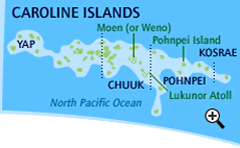The Canoe Is the People
Indigenous Navigation in the Pacific
Becoming a Navigator
Becoming a wayfinder GLOSSARY wayfinder – navigator in the Pacific is a lifelong experience. Learning happens in many places (the home, the vaka house, the sea) and in many ways.
On Satawal, everyone learns some things about vakas and sailing from a young age – for example, by playing with model vakas. Children, including girls, learn mostly from their father or uncles. If their mother is a wayfinder’s daughter, she teaches them what she knows too.
But there is also a lot of secret knowledge. This includes knowledge about navigation, vaka building, the weather, and even knot divination GLOSSARY divination - fortune-telling . The knowledge is like property. Secret navigational knowledge is passed on only through certain families. In the past, a tribal group without a navigator would sometimes pay to have a student trained. Some young men learn in the school of a reb (master navigator). They are initiated through a pwo (initiation ceremony for navigators). There were once many traditional schools in the central Carolines, but only two remain – Warieng and Faaluur.
In the Marshall Islands, navigational knowledge is considered a sacred gift from the ancestors. Only some families have access to it. Polynesian people say that knowledge is mana – the power to change. In Tonga, there were special navigator tribes like the Haa Fokololo oe Hau, who navigated the kalia (double hulled vakas) of the tui Tonga (kings). A young boy from a high family was chosen to learn on board. Some boys were trained as ula lahi (navigators), and some as lomu lahi (vaka builders).
In Duff Islands (including the biggest Duff Island, Taumako) babies are sometimes put in vakas to rock them to sleep. Children have small vakas so they can paddle and sail around the lagoon, and go fishing, go to the gardens, etc. The first job of a child on a voyaging canoe is to bail out water from the main hull. From that position in the center of the vaka the bailer can see and learn what the other crew members are doing. Each crew member has a job, and it takes a lot of experience at sea for anyone to really learn how to do each job in many different wind and sea conditions.
Father Teaching Son
(Caroline Islands, Micronesia)
One of the greatest wayfinders was Anoun Foeng, from Lukunor Atoll in the Caroline Islands. His son, Sou, loved to practise navigation with his father. One day, Anoun decided to test Sou's navigation skills by voyaging to Moen Island in Truk Lagoon. As they sailed, Anoun taught Sou many secrets of navigation.
One morning, after some time on Moen, Anoun took his son to the beach. There, they checked the weather. At sunrise, they chose a day to return. Helped by his father, Sou set their course for home and led the voyage. They stopped first at Losap Atoll in the Upper Mortlock Islands, then at Piafo. Piafo was very beautiful, and they stayed for some days. Sou didn't want to leave. But the journey couldn't continue without his son, so Anoun promised that Sou could own the island when they got home to Lukunor.
Sou couldn't imagine how this could be true - he didn't know that Anoun had spiritual powers called Ngorongorin Faneu. Anoun whispered to the spirits, and Piafo moved from the reef on Losap to the reef on Lukunor. Sou was overjoyed when he got home to find Piafo waiting for him.
In modern spelling Moen is Weno and Truk is spelled Chuuk.











